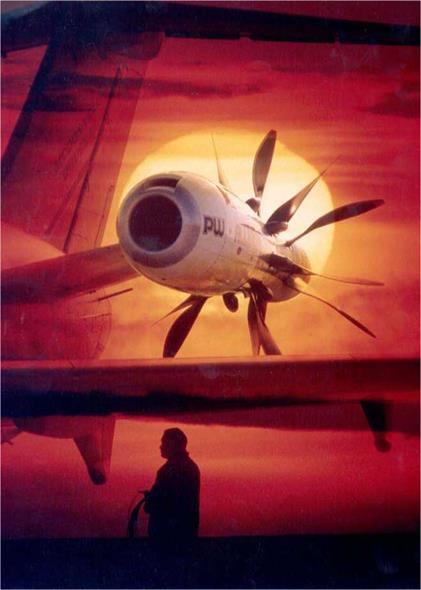Propfans
The Propfan is a turbine engine driving a tractor or pusher, single or contra-rotating, multi-bladed propeller of advance
|
The Eurocopter EC 130 with a tail rotor Fenestron, which reduces tail rotor noise by 50% due to its unevenly spaced blades. |
design. It was intended to be the power plant of the future for short to medium haul air transport aircraft. Turboprop aircraft are ideal for short haul feeder routes cruising at around 350 knots at altitudes up to 25,000 feet, while the jet transports cruise higher at 450-550 knots. The Propfan is designed to combine turboprop economy with jet transport performance. The Propfan’s major disadvantage is the fan blade’s high tip speed associated with the relatively high cruise speed of the aircraft. The high tip speed suffers from separation of the air flow boundary layer over the blades causing noise and a loss in efficiency due to compressibility problems. More of this later.
From the foregoing, it is obvious the Propfan is not an ordinary propeller, but an advanced turboprop designed to meet a specific need in the air transport industry. The Propfan is used on aircraft, which are designed to cruise at a much higher speed than conventional prop driven aircraft, and must be designed accordingly. The main difference between Propfan and propeller aircraft is the number and shape of the individual blades. The relatively straight shape of normal prop blades is totally unsuitable for the high operating transonic speeds of the Propfan. Therefore, the Propfan’s blades are swept back scimitar shape, with the sweepback being far more prominent than a turboprop’s scimitar shaped blades. This shape is essential to maintain efficiency at high transonic speeds for the same reason a jet aircraft’s wings are swept back. The blades are designed as high-speed airfoils with a thin lenticular section and high aspect ratio planform, producing a high lift/drag ratio. A very high helix angle is also used, which combined with its high advance per rev produces in effect, a relatively slow air flow over the blades. Ironically, although transonic speeds require a prop with scimitar shaped blades, a straight blade is required for a fully supersonic propeller, due to aeroelasticity problems of stress and flutter where a straight prop blade is superior to a scimitar blade.
|
|
A dramatic double-exposure of the McDonnell Douglas MD – 80 test-bed with the P&W Allison Model 578-DX Propfan, at sunset. Photo courtesy Hamilton Standard, Connecticut, USA.
Propfan blades are made from titanium or composite materials to provide greater strength, lightweight and stiffness. It is much easier to attach a great number of lightweight composite blades to a prop hub than heavier metal blades. Six – blade composite props are becoming more common on new generation turboprop transport aircraft, with up to twelve blades being used on a contra-prop allowing smaller diameter props. The Propfan blades appear to be short and stubby due to the hub/radius ratio of 0.45, double that of a conventional propeller. This provides the advantage of lower tip speeds of around 750-800 feet per minute, although some Propfans may have tip speeds operating in the transonic range of Mach 0.8 to 1.2, if the designer requires this. Although it maybe acceptable for a Propfan’s blade tip to operate in this range, the rest of the blade is usually operating at the more conventional subsonic speeds. On a conventional prop, smaller blades have a reduced diameter with increased prop disc loading, leading to a loss in efficiency. Adding a greater number of blades, as found on a contra-Propfan for example, reduces the prop blade loading thereby regaining the lost efficiency. The multi-bladed Propfan handles the undesirable problem of compressibility better than a conventional prop. The air flow through the Propfan cascades over the numerous blades allowing compressibility to build up gradually with a minimum loss of energy. Depending on the Propfan’s design, the prop disc loading (as opposed to prop blade loading) may be similar or up to twice that of a conventional propeller
The number of blades, small diameter, scimitar shape and high aspect ratio, all leads to an increase in propulsive efficiency 20% better than a conventional high by-pass turbofan at Mach 0.8. At cruising speeds between Mach 0.7 and 0.85, the propulsive efficiency is about 72-80% for a single-rotation Propfan and 85-90% for a contra-Propfan. This puts the Propfan’s efficiency as being better than both a conventional prop and turbofan at the Propfan’s design cruise speed of around 450 knots.
Fuel burn will be down 25-45% less than a conventional jet engine, which was the original reason for developing the Propfan due to the fuel crises of the mid 1970s. The fuel burn figures and propulsive efficiency for a contra-Propfan are better than those for a single rotation Propfan. The wake turbulence between the two fans of a contra-Propfan increases noise by 2-3 dB, although the aft fan will recoup some of the lost power in the wake from the front fan. Installing a duct or shroud around the Propfan will attenuate the noise, which being higher than a conventional prop is a distinct disadvantage for a civil transport aircraft. With a duct or shroud installed, the Propfan then becomes known as a Ducted Fan. In the rare event of the prop throwing a blade, it could be contained within the shroud, a distinct advantage especially on an airship!
For all its advantages, the Propfan research ended in the USA, however it continued slowly in Russia with production models now flying.













